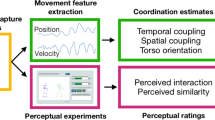Abstract
Dance is one type of movement that expresses emotion, however perceptions of dance movements and the corresponding trait inferences of the dancer have received no attention in the literature. This study examined how people determine dancer trait and emotion characteristics from point-light displays of dance, and whether dance experience affects differential attunements to dance movements. Dancers performed one “sad” and one “happy” dance while being filmed in point light, which is a technique used to isolate movement cues from other person information (such as race, sex, height). Experienced dancers and dance novices served as participants and judged the dances on two types of measures—movement (e.g., constricted-open) and dancer trait characteristics (e.g., happy-sad). The results revealed that all participants easily judged happy dances as happier, stronger, and more approachable, dominant, and extroverted than sad dances. However, movement judgments of happy dances were affected by experience, as experienced dancers perceived movements in the happy dances to be less free, fluid, and relaxed, but more exaggerated, than did novices. These results support ecological theory (McArthur & Baron, 1983) in that all were easily able to determine dancer traits and emotion from dances, but fine discriminations among the dance movements during fast, happy dances were typically made only by those who had dance training and were attuned to minute motion differences.
Similar content being viewed by others
References
BARCLAY, C. D., CUTTING, J. R., & KOZLOWSKI, L. T. (1978). Temporal and spatial factors in gait perception that influence gender recognition. Perception and Psychophysics, 23, 145–152.
BERGER, M. R. (1992). Isadora Duncan and the creative source of dance therapy. American Journal of Dance Therapy, 14, 95–110.
BERRY, D. S. (1990). The perceiver as naive scientist, or the scientist as naive perceiver? An ecological view of social knowledge acquisition. Contemporary Social Psychology, 14, 145–153.
BERRY, D. S., KEAN, K. J., MISOVICH, S. J., & BARON, R. M. (1991). Quantized displays of human movement: A methodological alternative to the point-light display. Journal of Nonverbal Behavior, 15, 81–97.
BERRY, D. S., & MISOVICH, S. J. (1994). Methodological approaches to the study of social event perception. Personality and Social Psychology Bulletin, 20, 139–152.
CHENEY, G. (1989). Basic concepts in modern dance: A creative approach. Princeton, NJ: Princeton Book Company.
CUTTING, J. E., & PROFFITT, D. R. (1981). Gait perception as an example of how we may perceive events. Intersensory Perception and Sensory Interaction, 10, 249–273.
CUTTING, J. E., PROFFITT, D. R., & KOZLOWSKI, L T. (1978). A biochemical invariant for gait perception. Journal of Experimental Psychology: Human Perception and Performance, 4, 357–372.
FRABLE, D. E. S. (1978). Sex-typed execution and perception of expressive movement. Journal of Personality and Social Psychology, 53, 391–396.
GIBSON, E. J., & SPELKE, E. (1983). The development of perception. In P. Mussen (Series Ed.), and J. H. Flavell & E. Markman (Volume Eds.), Handbook of child psychology: Vol. 3: Cognitive development (4th ed., pp. 2–76). New York: Wiley.
JOHANSSON, G. (1973). Visual perception of biological motion and model for its analysis. Perception and Psychophysics, 14, 201–211.
KOZLOWSKI, L. T., & CUTTING, J. E. (1977). Recognizing the sex of a walker from a dynamic point-light display. Perception and Psychophysics, 21, 575–580.
LEVY, F J. (1988). Dance movement therapy. Reston, VA: National Dance Association.
MCARTHUR, L. Z. (1984, April). Perception affords conception. Paper presented at the 55th Annual Meeting of the Eastern Psychological Association, Baltimore, MD.
MCARTHUR, L. Z., & BARON, R. M. (1983). Toward an ecological theory of social perception. Psychological Review, 90, 215–238.
MONTEPARE, J. M., & ZEBROWITZ, L. A. (1993). A cross-cultural comparison of impression created by age-related variations in gait. Journal of Nonverbal Behavior, 17, 55–67.
MONTEPARE, J. M., & ZEBROWITZ-MCARTHUR, L. A. (1988). Impressions of people created by age-related qualities of their gaits. Journal of Personality and Social Psychology, 55, 547–556.
ROYCE, A. P. (1984). Movement and meaning: Creativity and interpretation in ballet and mime. Bloomington, IN: Indiana University Press.
RUNESON, S., & FRYKHOLM, S. (1983). Kinematic specification of dynamics as an informational basis for person-and-action perception: Expectation, gender recognition and deceptive intention. Journal of Experimental Psychology: General, 112, 585–615.
WALLBOTT, H. G. (1992). Effects of distortion of spatial and temporal resolution of video stimuli on emotion attributions. Journal of Nonverbal Behavior, 16, 5–20.
WALTER, K., ERVIN, S. L, & BROWNLOW, S. (1996, March). Something in the way she moves: Judgments of traits and motion from point-light displays of gait. Presented at the 42nd annual meeting of the Southeastern Psychological Association, Norfolk, VA.
Author information
Authors and Affiliations
Corresponding author
Additional information
We are grateful to Lori Ledvina, Bev Lewis, John Morris, and John David Sheriff for choreographing and performing the dances, Bess Park Peterson for her technical dance advice, Natalie Gilbert for editing the stimulus tapes, and Kathy Walter for her advice on the manuscript. Portions of this research were presented through the Committee for Equality in Professional Opportunity at the 41st annual meeting of the Southeastern Psychological Association, March, 1995, Savannah GA.
Rights and permissions
About this article
Cite this article
Brownlow, S., Dixon, A.R., Egbert, C.A. et al. Perception of movement and dancer characteristics from point-light displays of dance. Psychol Rec 47, 411–422 (1997). https://doi.org/10.1007/BF03395235
Published:
Issue Date:
DOI: https://doi.org/10.1007/BF03395235




